Learning collocations to increase students’ word power in academic writing
One of the common frustrating experiences that most English as a foreign
language (EFL) teacher share in teaching writing classes is students’ poor lexical
resource leading the recurrence of students’ lexical errors, e.g., incorrect or improper
usage of lexicon, regardless of repeated correction or feedback. An important aspect of
native speakers’ language competence is collocational competence which involves
knowing which words usually come together and which do not. This paper investigates
the importance of learning collocations in increasing vocabulary resource in academic
writing because collocational knowledge distinguishes native speakers and foreign
language learners and is a significant factor in productive skills especially writing. This
article also examines the notion of collocations, differentiates definition and collocation
in vocabulary learning, explores the chief reasons why English learners need to learn
collocations and suggest some techniques to study collocations and use them effectively
in academic writing.
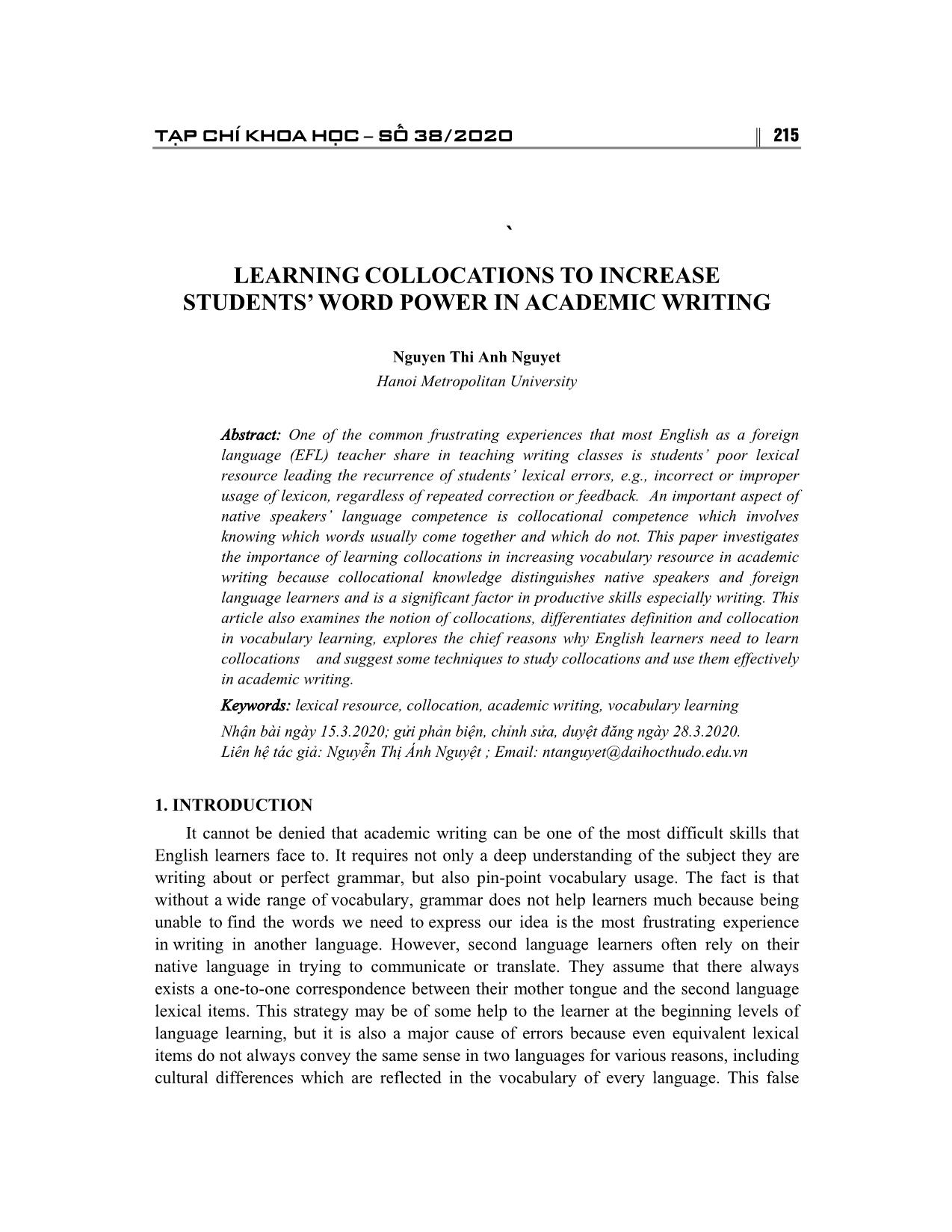
Trang 1
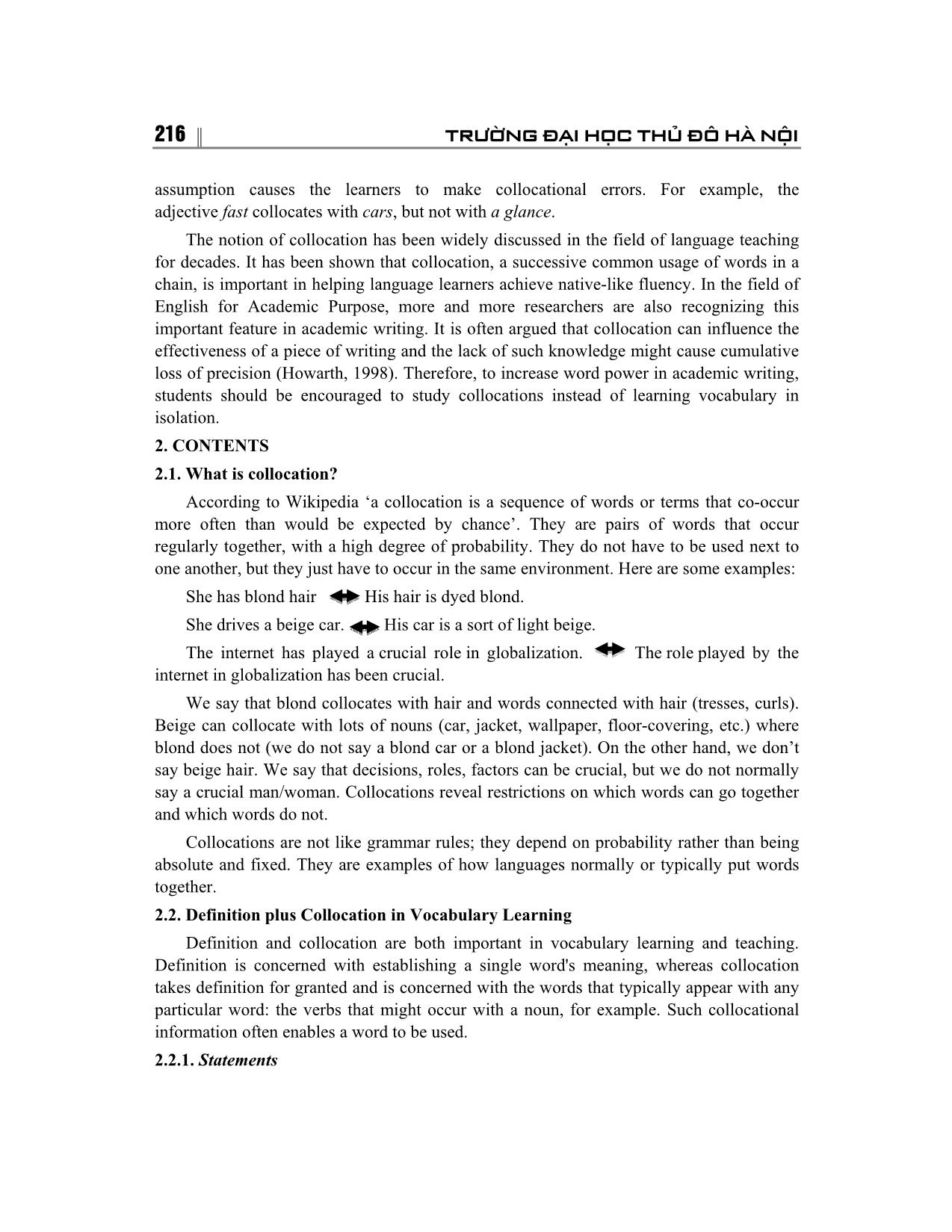
Trang 2
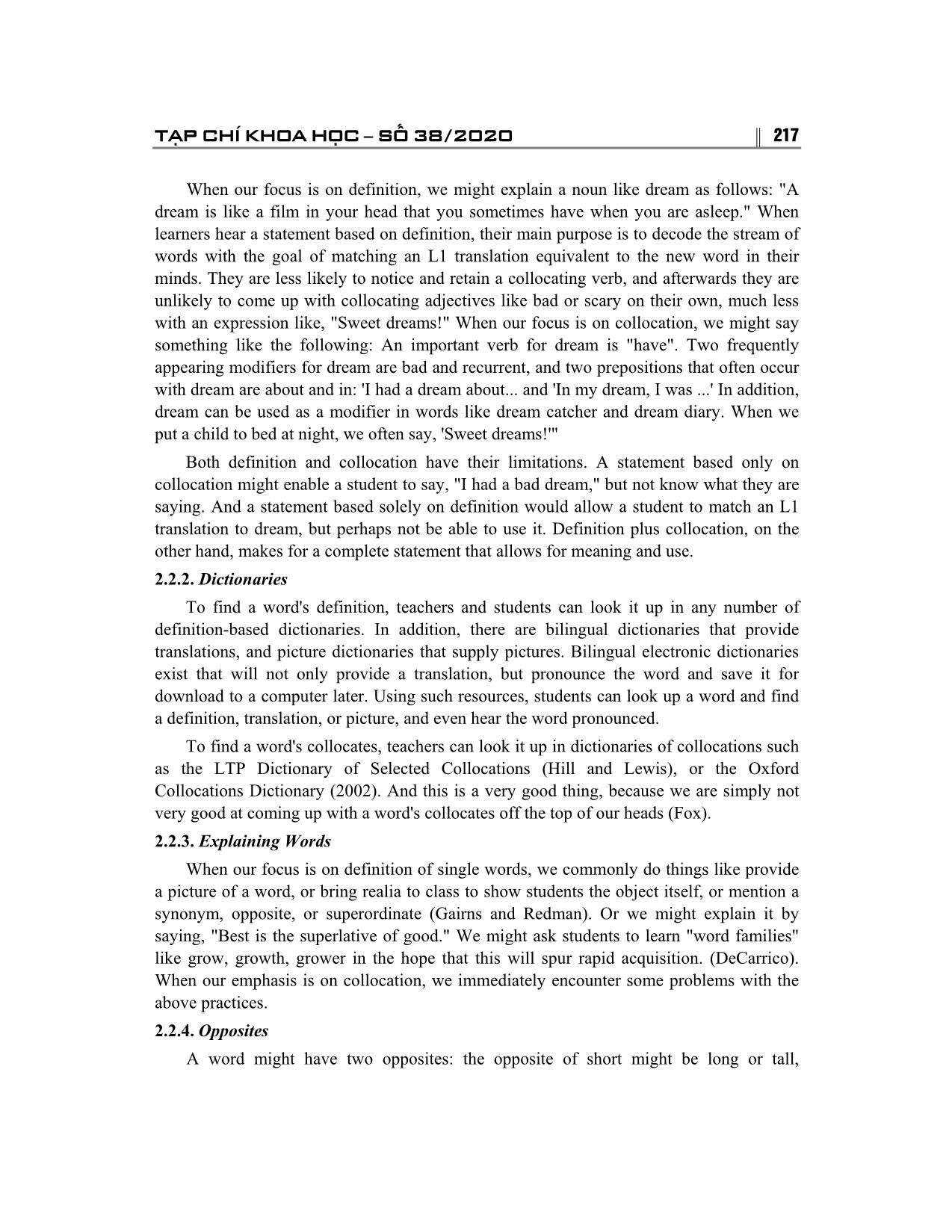
Trang 3
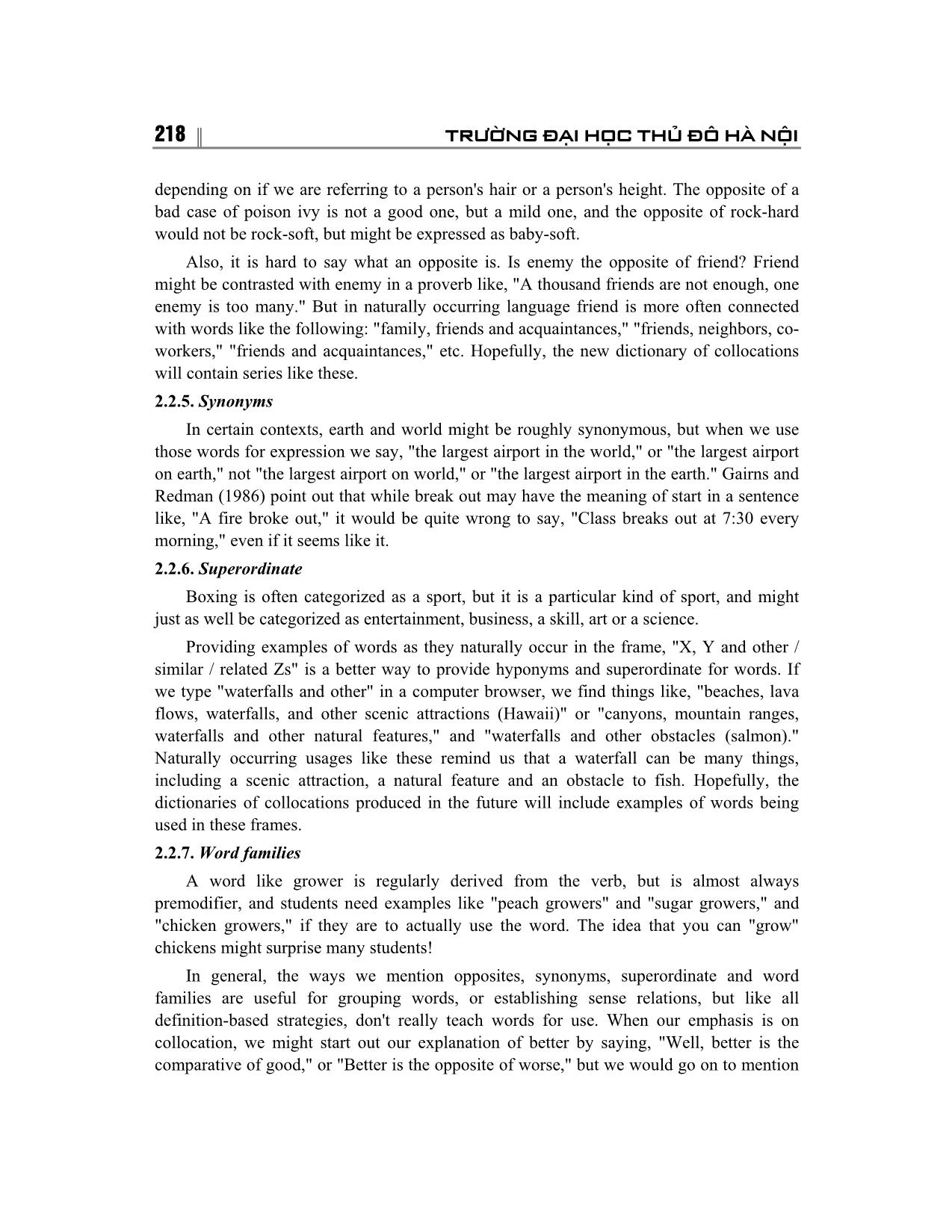
Trang 4
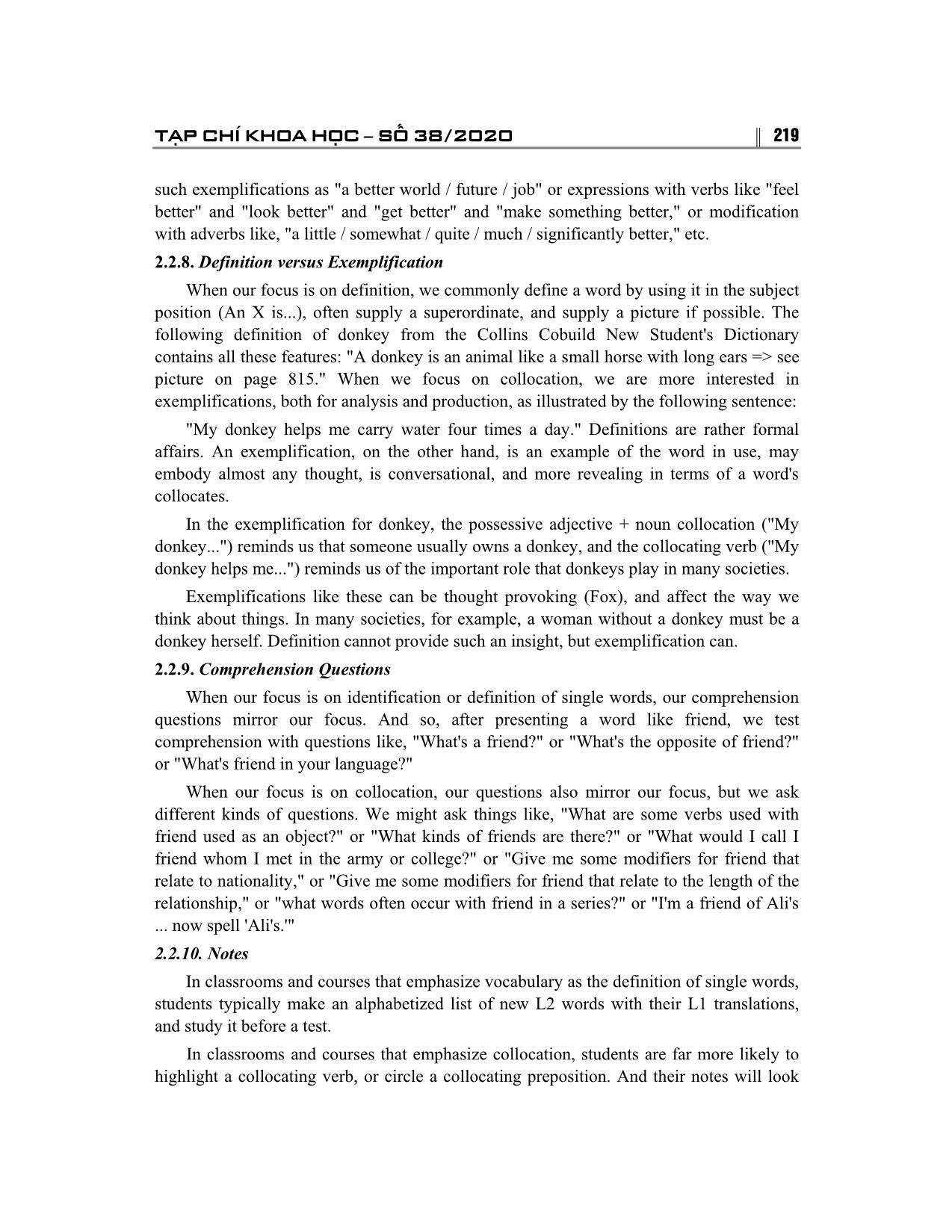
Trang 5
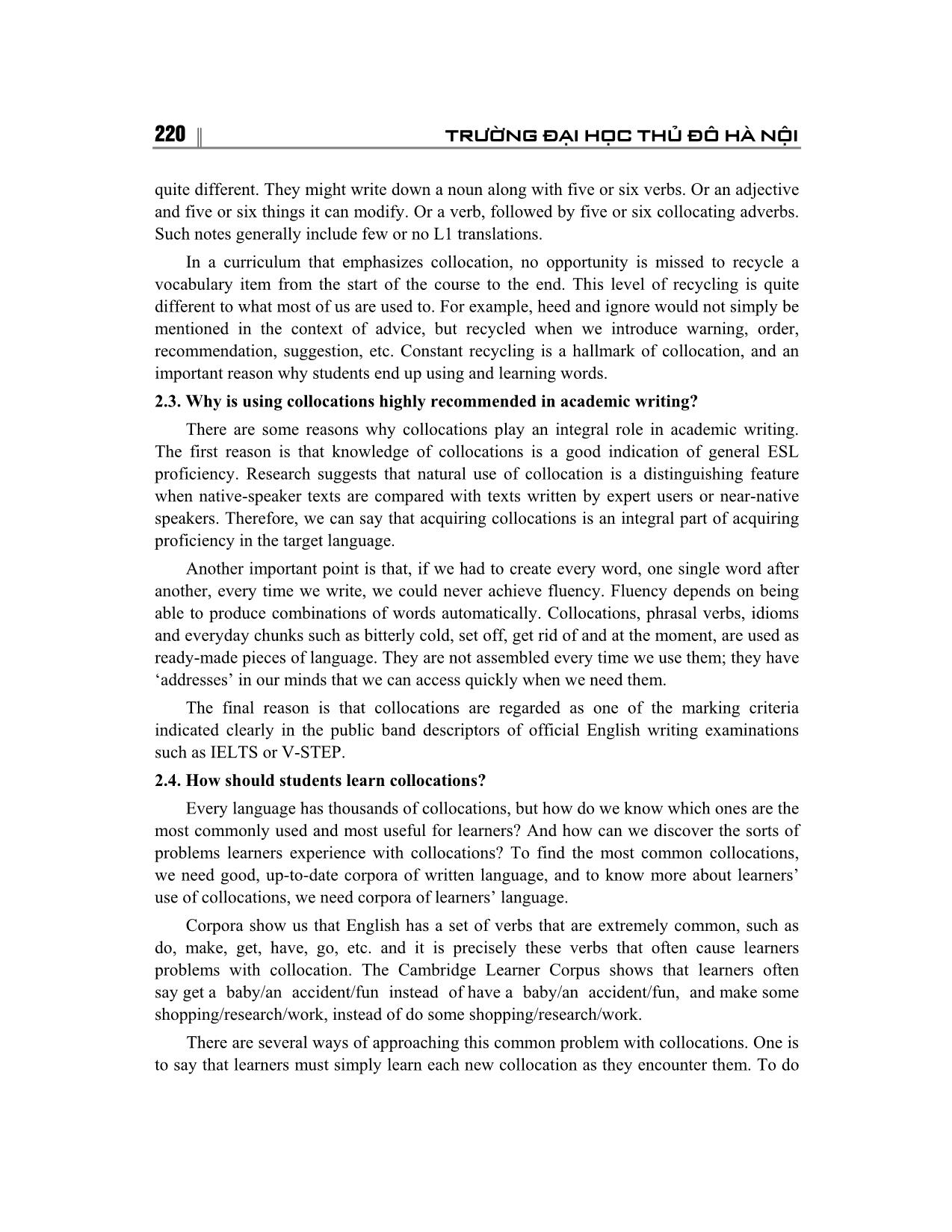
Trang 6
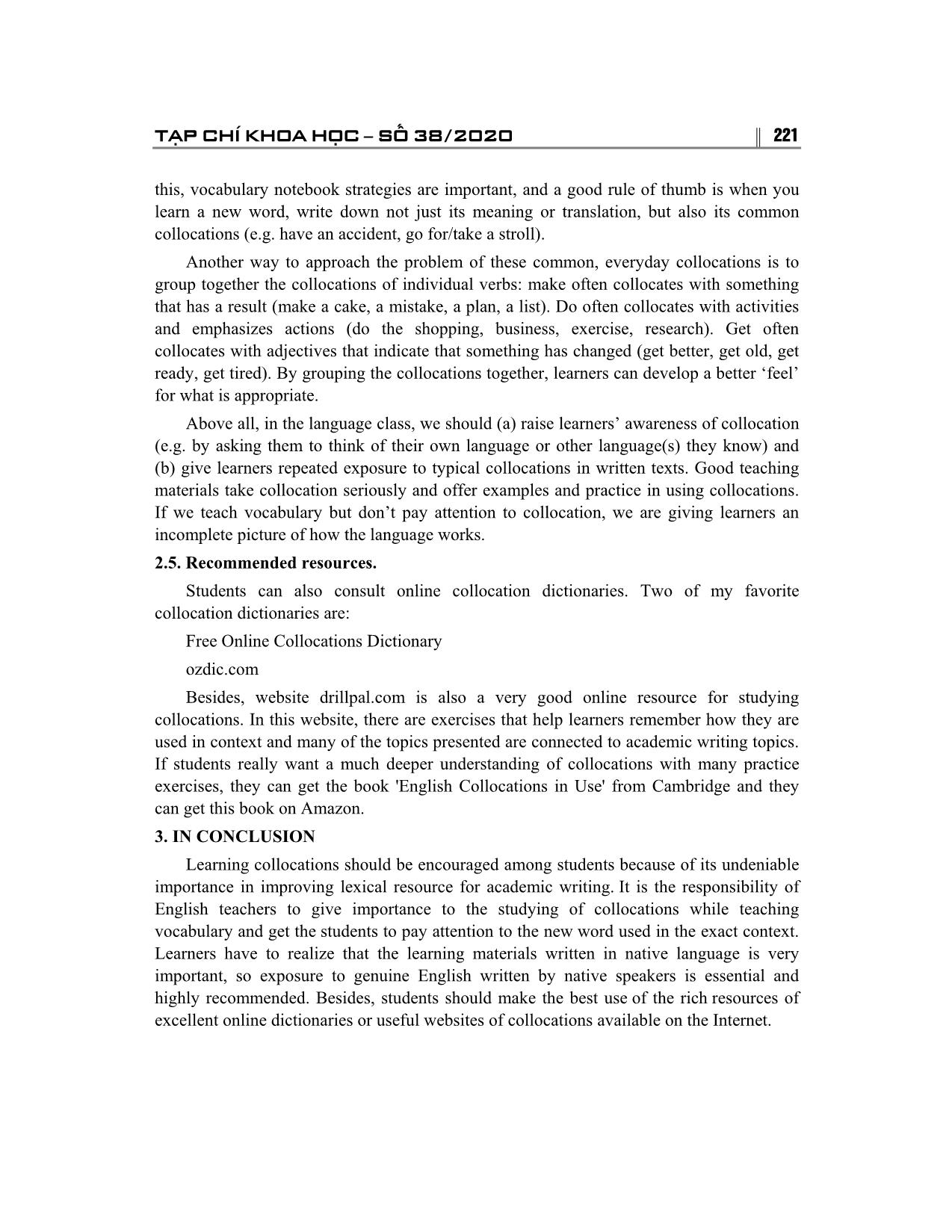
Trang 7
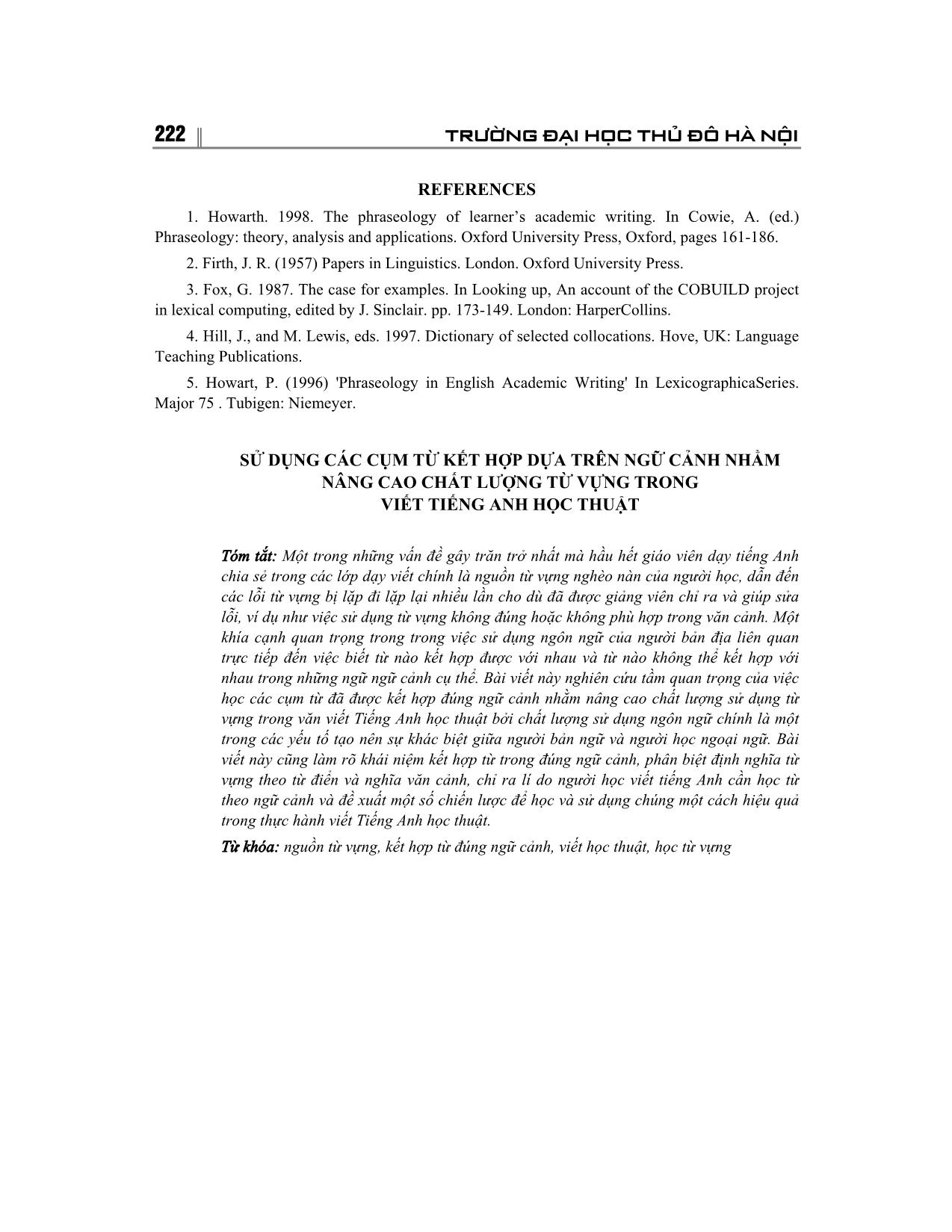
Trang 8
Tóm tắt nội dung tài liệu: Learning collocations to increase students’ word power in academic writing
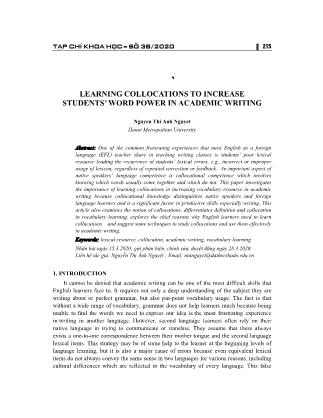
TẠP CHÍ KHOA HỌC SỐ 38/2020 215
`
LEARNING COLLOCATIONS TO INCREASE
STUDENTS’ WORD POWER IN ACADEMIC WRITING
Nguyen Thi Anh Nguyet
Hanoi Metropolitan University
Abstract: One of the common frustrating experiences that most English as a foreign
language (EFL) teacher share in teaching writing classes is students’ poor lexical
resource leading the recurrence of students’ lexical errors, e.g., incorrect or improper
usage of lexicon, regardless of repeated correction or feedback. An important aspect of
native speakers’ language competence is collocational competence which involves
knowing which words usually come together and which do not. This paper investigates
the importance of learning collocations in increasing vocabulary resource in academic
writing because collocational knowledge distinguishes native speakers and foreign
language learners and is a significant factor in productive skills especially writing. This
article also examines the notion of collocations, differentiates definition and collocation
in vocabulary learning, explores the chief reasons why English learners need to learn
collocations and suggest some techniques to study collocations and use them effectively
in academic writing.
Keywords: lexical resource, collocation, academic writing, vocabulary learning
Nhận bài ngày 15.3.2020; gửi phản biện, chỉnh sửa, duyệt đăng ngày 28.3.2020.
Liên hệ tác giả: Nguyễn Thị Ánh Nguyệt ; Email: ntanguyet@daihocthudo.edu.vn
1. INTRODUCTION
It cannot be denied that academic writing can be one of the most difficult skills that
English learners face to. It requires not only a deep understanding of the subject they are
writing about or perfect grammar, but also pin-point vocabulary usage. The fact is that
without a wide range of vocabulary, grammar does not help learners much because being
unable to find the words we need to express our idea is the most frustrating experience
in writing in another language. However, second language learners often rely on their
native language in trying to communicate or translate. They assume that there always
exists a one-to-one correspondence between their mother tongue and the second language
lexical items. This strategy may be of some help to the learner at the beginning levels of
language learning, but it is also a major cause of errors because even equivalent lexical
items do not always convey the same sense in two languages for various reasons, including
cultural differences which are reflected in the vocabulary of every language. This false
216 TRƯỜNG ĐẠI HỌC THỦ ĐÔ HÀ NỘI
assumption causes the learners to make collocational errors. For example, the
adjective fast collocates with cars, but not with a glance.
The notion of collocation has been widely discussed in the field of language teaching
for decades. It has been shown that collocation, a successive common usage of words in a
chain, is important in helping language learners achieve native-like fluency. In the field of
English for Academic Purpose, more and more researchers are also recognizing this
important feature in academic writing. It is often argued that collocation can influence the
effectiveness of a piece of writing and the lack of such knowledge might cause cumulative
loss of precision (Howarth, 1998). Therefore, to increase word power in academic writing,
students should be encouraged to study collocations instead of learning vocabulary in
isolation.
2. CONTENTS
2.1. What is collocation?
According to Wikipedia ‘a collocation is a sequence of words or terms that co-occur
more often than would be expected by chance’. They are pairs of words that occur
regularly together, with a high degree of probability. They do not have to be used next to
one another, but they just have to occur in the same environment. Here are some examples:
She has blond hair His hair is dyed blond.
She drives a beige car. His car is a sort of light beige.
The internet has played a crucial role in globalization. The role played by the
internet in globalization has been crucial.
We say that blond collocates with hair and words connected with hair (tresses, curls).
Beige can collocate with lots of nouns (car, jacket, wallpaper, floor-covering, etc.) where
blond does not (we do not say a blond car or a blond jacket). On the other hand, we don’t
say beige hair. We say that decisions, roles, factors can be crucial, but we do not normally
say a crucial man/woman. Collocations reveal restrictions on which words can go together
and which words do not.
Collocations are not like grammar rules; they depend on probability rather than being
absolute and fixed. They are examples of how languages normally or typically put words
together.
2.2. Definition plus Collocation in Vocabulary Learning
Definition and collocation are both important in vocabulary learning and teaching.
Definition is concerned with establishing a single word's meaning, whereas collocation
takes definition for granted and is concerned with the words that typically appear with any
particular word: the verbs that might occur with a noun, for example. Such collocational
information often enables a word to be used.
2.2.1. Statements
TẠP CHÍ KHOA HỌC SỐ 38/2020 217
When our focus is on definition, we might explain a noun like dream as follows: "A
dream is like a film in your head that you sometimes have when you are asleep." When
learners hear a statement based on definition, their main purpose is to decode the stream of
words with the goal of matching an L1 translation equivalent to the new word in their
minds. They are less likely to notice and retain a collocating verb, and afterwards they are
unlikely to come up with collocating adjectives like bad or scary on their own, much less
with an expression like, "Sweet dreams!" When our focus is on collocation, we might say
something like the following: An im ... ĐẠI HỌC THỦ ĐÔ HÀ NỘI
depending on if we are referring to a person's hair or a person's height. The opposite of a
bad case of poison ivy is not a good one, but a mild one, and the opposite of rock-hard
would not be rock-soft, but might be expressed as baby-soft.
Also, it is hard to say what an opposite is. Is enemy the opposite of friend? Friend
might be contrasted with enemy in a proverb like, "A thousand friends are not enough, one
enemy is too many." But in naturally occurring language friend is more often connected
with words like the following: "family, friends and acquaintances," "friends, neighbors, co-
workers," "friends and acquaintances," etc. Hopefully, the new dictionary of collocations
will contain series like these.
2.2.5. Synonyms
In certain contexts, earth and world might be roughly synonymous, but when we use
those words for expression we say, "the largest airport in the world," or "the largest airport
on earth," not "the largest airport on world," or "the largest airport in the earth." Gairns and
Redman (1986) point out that while break out may have the meaning of start in a sentence
like, "A fire broke out," it would be quite wrong to say, "Class breaks out at 7:30 every
morning," even if it seems like it.
2.2.6. Superordinate
Boxing is often categorized as a sport, but it is a particular kind of sport, and might
just as well be categorized as entertainment, business, a skill, art or a science.
Providing examples of words as they naturally occur in the frame, "X, Y and other /
similar / related Zs" is a better way to provide hyponyms and superordinate for words. If
we type "waterfalls and other" in a computer browser, we find things like, "beaches, lava
flows, waterfalls, and other scenic attractions (Hawaii)" or "canyons, mountain ranges,
waterfalls and other natural features," and "waterfalls and other obstacles (salmon)."
Naturally occurring usages like these remind us that a waterfall can be many things,
including a scenic attraction, a natural feature and an obstacle to fish. Hopefully, the
dictionaries of collocations produced in the future will include examples of words being
used in these frames.
2.2.7. Word families
A word like grower is regularly derived from the verb, but is almost always
premodifier, and students need examples like "peach growers" and "sugar growers," and
"chicken growers," if they are to actually use the word. The idea that you can "grow"
chickens might surprise many students!
In general, the ways we mention opposites, synonyms, superordinate and word
families are useful for grouping words, or establishing sense relations, but like all
definition-based strategies, don't really teach words for use. When our emphasis is on
collocation, we might start out our explanation of better by saying, "Well, better is the
comparative of good," or "Better is the opposite of worse," but we would go on to mention
TẠP CHÍ KHOA HỌC SỐ 38/2020 219
such exemplifications as "a better world / future / job" or expressions with verbs like "feel
better" and "look better" and "get better" and "make something better," or modification
with adverbs like, "a little / somewhat / quite / much / significantly better," etc.
2.2.8. Definition versus Exemplification
When our focus is on definition, we commonly define a word by using it in the subject
position (An X is...), often supply a superordinate, and supply a picture if possible. The
following definition of donkey from the Collins Cobuild New Student's Dictionary
contains all these features: "A donkey is an animal like a small horse with long ears => see
picture on page 815." When we focus on collocation, we are more interested in
exemplifications, both for analysis and production, as illustrated by the following sentence:
"My donkey helps me carry water four times a day." Definitions are rather formal
affairs. An exemplification, on the other hand, is an example of the word in use, may
embody almost any thought, is conversational, and more revealing in terms of a word's
collocates.
In the exemplification for donkey, the possessive adjective + noun collocation ("My
donkey...") reminds us that someone usually owns a donkey, and the collocating verb ("My
donkey helps me...") reminds us of the important role that donkeys play in many societies.
Exemplifications like these can be thought provoking (Fox), and affect the way we
think about things. In many societies, for example, a woman without a donkey must be a
donkey herself. Definition cannot provide such an insight, but exemplification can.
2.2.9. Comprehension Questions
When our focus is on identification or definition of single words, our comprehension
questions mirror our focus. And so, after presenting a word like friend, we test
comprehension with questions like, "What's a friend?" or "What's the opposite of friend?"
or "What's friend in your language?"
When our focus is on collocation, our questions also mirror our focus, but we ask
different kinds of questions. We might ask things like, "What are some verbs used with
friend used as an object?" or "What kinds of friends are there?" or "What would I call I
friend whom I met in the army or college?" or "Give me some modifiers for friend that
relate to nationality," or "Give me some modifiers for friend that relate to the length of the
relationship," or "what words often occur with friend in a series?" or "I'm a friend of Ali's
... now spell 'Ali's.'"
2.2.10. Notes
In classrooms and courses that emphasize vocabulary as the definition of single words,
students typically make an alphabetized list of new L2 words with their L1 translations,
and study it before a test.
In classrooms and courses that emphasize collocation, students are far more likely to
highlight a collocating verb, or circle a collocating preposition. And their notes will look
220 TRƯỜNG ĐẠI HỌC THỦ ĐÔ HÀ NỘI
quite different. They might write down a noun along with five or six verbs. Or an adjective
and five or six things it can modify. Or a verb, followed by five or six collocating adverbs.
Such notes generally include few or no L1 translations.
In a curriculum that emphasizes collocation, no opportunity is missed to recycle a
vocabulary item from the start of the course to the end. This level of recycling is quite
different to what most of us are used to. For example, heed and ignore would not simply be
mentioned in the context of advice, but recycled when we introduce warning, order,
recommendation, suggestion, etc. Constant recycling is a hallmark of collocation, and an
important reason why students end up using and learning words.
2.3. Why is using collocations highly recommended in academic writing?
There are some reasons why collocations play an integral role in academic writing.
The first reason is that knowledge of collocations is a good indication of general ESL
proficiency. Research suggests that natural use of collocation is a distinguishing feature
when native-speaker texts are compared with texts written by expert users or near-native
speakers. Therefore, we can say that acquiring collocations is an integral part of acquiring
proficiency in the target language.
Another important point is that, if we had to create every word, one single word after
another, every time we write, we could never achieve fluency. Fluency depends on being
able to produce combinations of words automatically. Collocations, phrasal verbs, idioms
and everyday chunks such as bitterly cold, set off, get rid of and at the moment, are used as
ready-made pieces of language. They are not assembled every time we use them; they have
‘addresses’ in our minds that we can access quickly when we need them.
The final reason is that collocations are regarded as one of the marking criteria
indicated clearly in the public band descriptors of official English writing examinations
such as IELTS or V-STEP.
2.4. How should students learn collocations?
Every language has thousands of collocations, but how do we know which ones are the
most commonly used and most useful for learners? And how can we discover the sorts of
problems learners experience with collocations? To find the most common collocations,
we need good, up-to-date corpora of written language, and to know more about learners’
use of collocations, we need corpora of learners’ language.
Corpora show us that English has a set of verbs that are extremely common, such as
do, make, get, have, go, etc. and it is precisely these verbs that often cause learners
problems with collocation. The Cambridge Learner Corpus shows that learners often
say get a baby/an accident/fun instead of have a baby/an accident/fun, and make some
shopping/research/work, instead of do some shopping/research/work.
There are several ways of approaching this common problem with collocations. One is
to say that learners must simply learn each new collocation as they encounter them. To do
TẠP CHÍ KHOA HỌC SỐ 38/2020 221
this, vocabulary notebook strategies are important, and a good rule of thumb is when you
learn a new word, write down not just its meaning or translation, but also its common
collocations (e.g. have an accident, go for/take a stroll).
Another way to approach the problem of these common, everyday collocations is to
group together the collocations of individual verbs: make often collocates with something
that has a result (make a cake, a mistake, a plan, a list). Do often collocates with activities
and emphasizes actions (do the shopping, business, exercise, research). Get often
collocates with adjectives that indicate that something has changed (get better, get old, get
ready, get tired). By grouping the collocations together, learners can develop a better ‘feel’
for what is appropriate.
Above all, in the language class, we should (a) raise learners’ awareness of collocation
(e.g. by asking them to think of their own language or other language(s) they know) and
(b) give learners repeated exposure to typical collocations in written texts. Good teaching
materials take collocation seriously and offer examples and practice in using collocations.
If we teach vocabulary but don’t pay attention to collocation, we are giving learners an
incomplete picture of how the language works.
2.5. Recommended resources.
Students can also consult online collocation dictionaries. Two of my favorite
collocation dictionaries are:
Free Online Collocations Dictionary
ozdic.com
Besides, website drillpal.com is also a very good online resource for studying
collocations. In this website, there are exercises that help learners remember how they are
used in context and many of the topics presented are connected to academic writing topics.
If students really want a much deeper understanding of collocations with many practice
exercises, they can get the book 'English Collocations in Use' from Cambridge and they
can get this book on Amazon.
3. IN CONCLUSION
Learning collocations should be encouraged among students because of its undeniable
importance in improving lexical resource for academic writing. It is the responsibility of
English teachers to give importance to the studying of collocations while teaching
vocabulary and get the students to pay attention to the new word used in the exact context.
Learners have to realize that the learning materials written in native language is very
important, so exposure to genuine English written by native speakers is essential and
highly recommended. Besides, students should make the best use of the rich resources of
excellent online dictionaries or useful websites of collocations available on the Internet.
222 TRƯỜNG ĐẠI HỌC THỦ ĐÔ HÀ NỘI
REFERENCES
1. Howarth. 1998. The phraseology of learner’s academic writing. In Cowie, A. (ed.)
Phraseology: theory, analysis and applications. Oxford University Press, Oxford, pages 161-186.
2. Firth, J. R. (1957) Papers in Linguistics. London. Oxford University Press.
3. Fox, G. 1987. The case for examples. In Looking up, An account of the COBUILD project
in lexical computing, edited by J. Sinclair. pp. 173-149. London: HarperCollins.
4. Hill, J., and M. Lewis, eds. 1997. Dictionary of selected collocations. Hove, UK: Language
Teaching Publications.
5. Howart, P. (1996) 'Phraseology in English Academic Writing' In LexicographicaSeries.
Major 75 . Tubigen: Niemeyer.
SỬ DỤNG CÁC CỤM TỪ KẾT HỢP DỰA TRÊN NGỮ CẢNH NHẰM
NÂNG CAO CHẤT LƯỢNG TỪ VỰNG TRONG
VIẾT TIẾNG ANH HỌC THUẬT
Tóm tắt: Một trong những vấn đề gây trăn trở nhất mà hầu hết giáo viên dạy tiếng Anh
chia sẻ trong các lớp dạy viết chính là nguồn từ vựng nghèo nàn của người học, dẫn đến
các lỗi từ vựng bị lặp đi lặp lại nhiều lần cho dù đã được giảng viên chỉ ra và giúp sửa
lỗi, ví dụ như việc sử dụng từ vựng không đúng hoặc không phù hợp trong văn cảnh. Một
khía cạnh quan trọng trong trong việc sử dụng ngôn ngữ của người bản địa liên quan
trực tiếp đến việc biết từ nào kết hợp được với nhau và từ nào không thể kết hợp với
nhau trong những ngữ ngữ cảnh cụ thể. Bài viết này nghiên cứu tầm quan trọng của việc
học các cụm từ đã được kết hợp đúng ngữ cảnh nhằm nâng cao chất lượng sử dụng từ
vựng trong văn viết Tiếng Anh học thuật bởi chất lượng sử dụng ngôn ngữ chính là một
trong các yếu tố tạo nên sự khác biệt giữa người bản ngữ và người học ngoại ngữ. Bài
viết này cũng làm rõ khái niệm kết hợp từ trong đúng ngữ cảnh, phân biệt định nghĩa từ
vựng theo từ điển và nghĩa văn cảnh, chỉ ra lí do người học viết tiếng Anh cần học từ
theo ngữ cảnh và đề xuất một số chiến lược để học và sử dụng chúng một cách hiệu quả
trong thực hành viết Tiếng Anh học thuật.
Từ khóa: nguồn từ vựng, kết hợp từ đúng ngữ cảnh, viết học thuật, học từ vựng
File đính kèm:
 learning_collocations_to_increase_students_word_power_in_aca.pdf
learning_collocations_to_increase_students_word_power_in_aca.pdf

